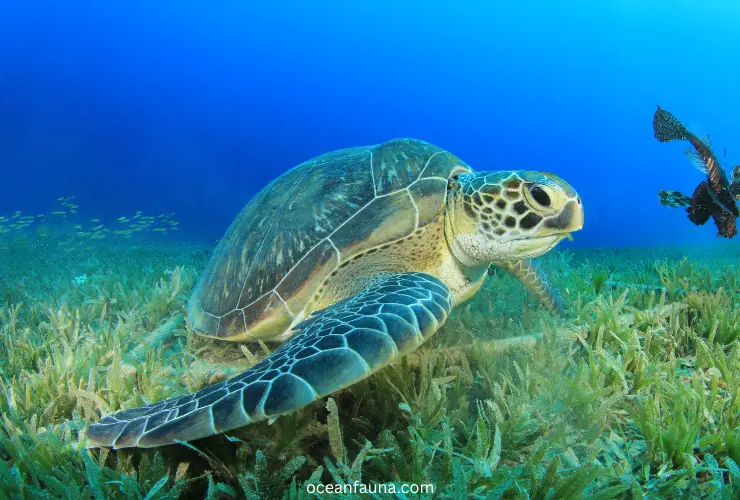Sea turtle eggs have an incubation period of about 45 to 70 days, depending on the species and environmental conditions. They are known for their unique nesting habits, where they lay their eggs on sandy beaches.
Sea turtles are fascinating creatures that start their lives as tiny hatchlings on beaches worldwide. But how long does it take them to emerge from their eggs and start their journey to adulthood?
We’ll dive deeper into the world of sea turtle eggs, explore the factors that affect their hatching time, what threats they could face, and even talk about their nesting process. So, let’s get started!
When Do Sea Turtles Lay Eggs?
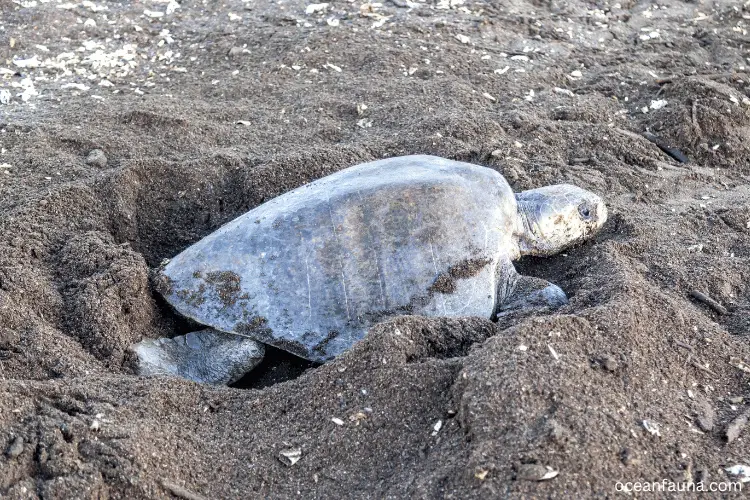
The months of May through September are the nesting period for sea turtles. And that is when they lay their eggs.
Sea turtles may lay their eggs all year in tropical regions. On the other hand, in the Southern Hemisphere, they usually do so from October to February, when the weather is warm.
Here are some examples of the different species of sea turtles and when they lay their eggs:
- Loggerhead sea turtles: Nesting season normally lasts from May through August, with June and July being the most productive months for nesting.
- Green sea turtles: From June through September, birds normally lay their eggs.
- Leatherback sea turtles: The normal period for nesting is from March through July.
- Hawksbill sea turtles: Their nesting season lasts from June through September.
- Olive Ridley sea turtles: The nesting season lasts from June until December.
How Many Eggs Do Sea Turtles Lay?
The quantity of eggs in a sea turtle’s nest varies depending on the species. The nest of a sea turtle is called a clutch. Sea turtles may produce 2 to 8 nests every season and lay an average of 110 eggs per nest.
The flatback turtle lays about 50 eggs per clutch and has the lowest clutch size. The hawksbill turtle, which may lay around 200 eggs in a nest, lays the biggest batches.
Green turtles typically lay 110 eggs per nest, while larger clutches have been documented with up to 238 eggs.
In the Caribbean, hawksbills often lay 150 eggs per nest, ranging from 86 to 206 eggs per nest.
Fun Fact: According to statistics from Seychelles in the Indian Ocean, there are 182 eggs on average in each nest (between 160 and 242), an even larger average clutch size.
Where Do the Sea Turtles Lay Their Eggs? (Nesting Process)
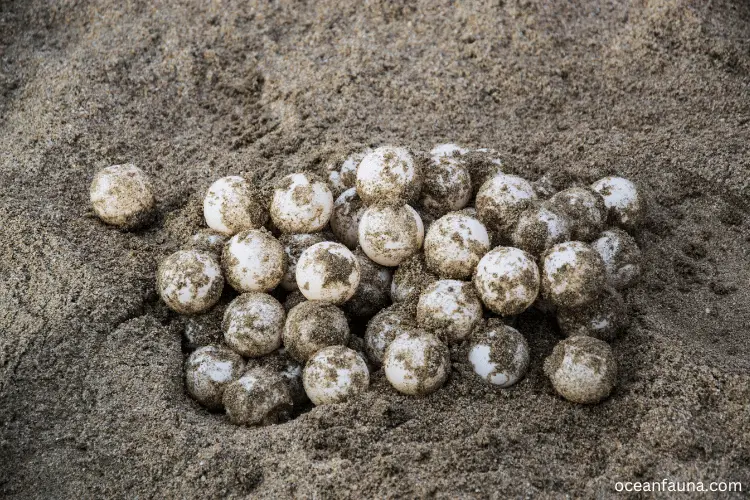
Sea turtles use sandy beaches and lower dunes as nesting grounds along the coast. These habitats are often found in the tropics and subtropics, where the sand is warm enough for the eggs to develop.
Once the sea turtle selects a location, the nesting process starts.
a) Emergence from the sea
The female turtle emerges from the water at night and approaches the beach in search of a good place to lay her eggs.
b) Digging a body pit
Once reaching the selected nesting location, the turtle uses all four flippers to dig up a body at the entrance. She scoops up the dry surface sand that would eventually cover the egg chamber from beneath her.
c) Digging an egg chamber
After making a body hole, she uses her rear flippers to start digging an egg chamber. She switches between the right and left flippers to scrape up the wet sand.
d) Laying eggs
Her rear flippers rise off the sand as she pauses and starts contracting when she can no longer go deeper. She soon started to deposit eggs. The female turtle will immediately release one to four eggs after each contraction.
e) Covering the egg chamber
The mother turtle uses her back flippers to push sand over the top of the egg cavity once all the eggs are inside.
f) Returning to the sea
Sea turtles leave the nesting place and start the long journey back to the sea after completing the laborious and drawn-out nest-laying procedure.
The fact that turtles frequently pause and take rest means that this activity will take longer than emerging. You can frequently hear them grunting and puffing as they make their tough last crawl to the water.
How Long Does It Take a Sea Turtle’s Egg to Hatch?
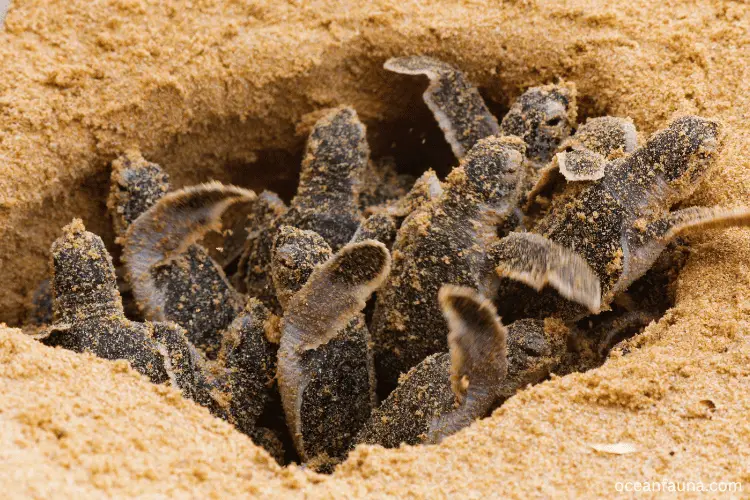
A turtle egg incubation period is around 50-75 days. However, the incubation time of different species of turtles can differ.
And factors such as temperature can influence the hatching time of turtle eggs.
The hatchlings emerge from their eggs around Day 70-80, typically weighing 1-3 ounces.
On average, the time taken for a sea turtle’s egg to hatch is 45 to 70 days. Here is a list of the hatching periods for different sea turtle species.
| Sea Turtle Species | Hatching Period |
| Green sea turtle | 50 to 70 days. |
| Hawksbill sea turtle | Around 60 days. |
| Kemp’s ridley sea turtle | Around 50 to 60 days. |
| Leatherback sea turtle | Around 60 to 70 days. |
| Loggerhead sea turtle | Around 50 to 60 days. |
- The Green Sea turtle: with their 50 to 70 days of incubation, can be attributed to its tropical nesting habitats, where temperature fluctuations and sand moisture affect development.
- Hawksbill sea turtles: Their 60-day period reflects their adaptation to stable tropical climates and specialized nesting behaviors.
- Kemp’s ridley sea turtles: hatching in 50 to 60 days may synchronize to increase hatchling survival during mass nesting events.
- Leatherback sea turtles: take 60 to 70 days, and have longer periods, possibly due to their larger size, colder nesting regions, and different physiological requirements.
- Loggerhead sea turtles: with a lifespan of around 50 to 60 days, they display adaptability to various environments and nesting sites, adjusting their development to local conditions.
Read more here to learn the Guidelines for Turtle Hatchery Management.
What Are the Threats to Sea Turtles During the Hatching Process?
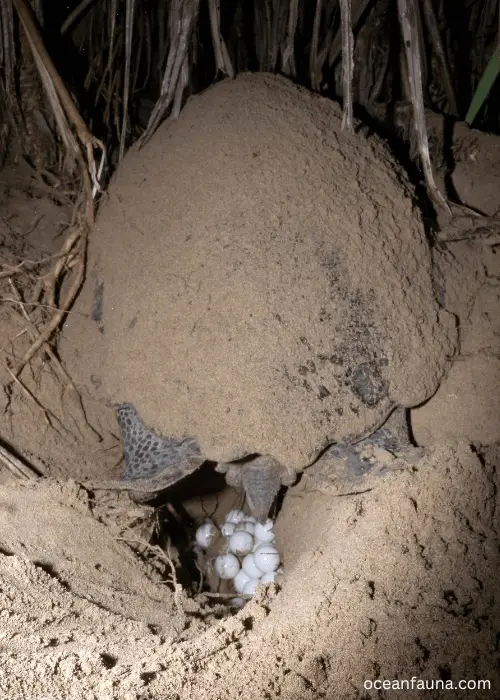
1. Predators
Sharks, seagulls, raccoons, and other predatory animals pose a threat to sea turtle hatchlings.
They may eat the eggs and hatchlings while in the nest or when they leave and head for the ocean.
2. Artificial lighting
Sea turtle hatchlings may become confused by near-shore lighting. Instead of going towards the water, they could stray inland in search of artificial lights.
This increases the risk of being dehydrated, becoming prey, or being hit by a car on busy coastal roads.
3. Human use of nesting beaches
Sea turtles may be negatively impacted by human activity on breeding beaches. Various factors threaten sea turtles during the growing process, including:
- Habitat deterioration
- Pollution
- Unintentional fishing gear capture.
These actions may interfere with nesting and threaten the survival of hatchlings.
4. Climate change
Climate change-related temperature increases have a big influence on sea turtle populations. A population imbalance can result from higher sand temperatures affecting the sex ratio of hatchlings.
The birth of fewer male sea turtles may occur due to unusually high temperatures brought on by climate change.
5. Plastic and other marine debris
Sea turtles are at risk of eating or becoming tangled in marine waste products, including plastic. Hatchlings might consume plastic and risk damage
if they think it’s food. Furthermore, litter on beaches and the ocean might obstruct hatchlings’ mobility and compromise their survival.
6. Coastal development
Development can disturb sea turtles’ natural environment near mangroves, nesting beaches, and other coastal locations.
Hatchlings’ chances of survival can be reduced by habitat loss, pollution, and construction activities that prevent them from getting to the ocean.
What Can Cause a Change in Hatching Time of The Egg?
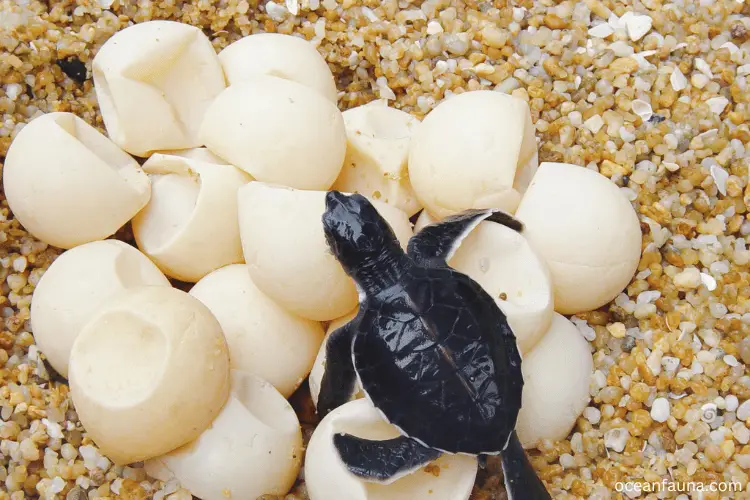
Several factors can cause a change in the hatching time of sea turtle eggs. Here are some of the possible causes:
1. Temperature
The temperature of the sand plays a crucial role in determining the hatching time of sea turtle eggs. Warmer temperatures generally result in faster development and shorter incubation periods.
On the other hand, cooler temperatures can slow and prolong the incubation period. Temperature changes can occur due to variations
in weather patterns, climate change, or even localized factors such as shading or exposure to direct sunlight.
2. Humidity
The period at which sea turtle eggs hatch is greatly influenced by the temperature of the sand.
In general, warmer temperatures lead to quicker growth and shorter incubation times, but cooler temperatures might cause slower development and a longer incubation time.
Climate change, differences in weather patterns, and even regional characteristics like shade or exposure to direct sunlight may all affect local temperatures.
3. Nest depth
When sea turtle eggs hatch, it may also depend on how humid the nest is. Higher humidity levels, as opposed to lower humidity levels, could promote more rapid development.
Changes in humidity may be influenced by rainfall, evaporation, or vegetation that affects moisture retention in the nest.
4. Nest relocation
Sea turtle nests may need to be moved because of dangers, including erosion, predation, or human interference.
Moving nests can disturb the ecosystem and cause changes in temperature, humidity, or other environmental variables, which may affect how quickly the eggs hatch.
5. Egg age
The eggs’ age when laid might also affect when they hatch. Older eggs could take longer to mature and hatch than fresher eggs.
This could happen if the female turtle waits to deposit eggs or if the eggs are safely preserved before being placed. Their age can impact the viability and pace of development of the eggs.
FAQs
Do Sea Turtles Lay All Their Eggs at Once?
No, sea turtles do not lay all their eggs at once. Throughout the nesting season, they produce many clutches of eggs. During the nesting season, a female can create up to 200 eggs in her many nests.
Do sea turtles lay their eggs on Shell Beach?
Yes, Olive Ridley Sea turtles lay their eggs on Shell Beach. December is the best time to visit Shell Beach to see the sea turtle nesting season.
Do sea turtles hatch their eggs at Tortuguero National Park?
Yes, Green Sea turtles are known to nest at Tortuguero National Park. April through October are the finest months to go and witness the turtle eggs hatching.
Do sea turtles hatch their eggs at Florida’s Fernandina Beach?
Yes. Sea turtle hatchling viewing is quite popular at Fernandina Beach on Amelia Island. The easiest way to get site-specific predictions is to contact local organizations. The hatching season lasts from April to October.
Do sea turtles hatch their eggs at Jupiter Beach Resort & Spa, Florida?
Sea turtles find Jupiter Beach Resort & Spa in Jupiter, Florida, the perfect site to lay their eggs. From mid-June to August is the best period to watch sea turtle hatchlings.
Do sea turtles hatch their eggs at Padre Island National Seashore, Texas?
Kemp’s ridley sea turtles nest at Padre Island National Seashore. Mid-June through August is the best period to see sea turtle hatchlings in this area.
Conclusion
Sea turtle hatchlings have a relatively poor survival rate and must overcome several obstacles as they migrate to the ocean.
Only around one in 1,000 sea turtle eggs hatch and grow up. If they don’t reach the water in time, hatchlings die from dehydration. They can also be eaten by fish, birds, crabs, raccoons, and other predators.

